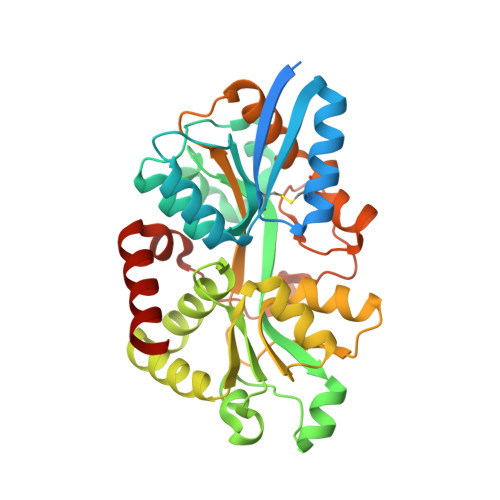Actinobacillus utilizes a binding protein-dependent ABC transporter to acquire the active form of vitamin B 6 .
Pan, C., Zimmer, A., Shah, M., Huynh, M.S., Lai, C.C., Sit, B., Hooda, Y., Curran, D.M., Moraes, T.F.(2021) J Biol Chem 297: 101046-101046
- PubMed: 34358566
- DOI: https://doi.org/10.1016/j.jbc.2021.101046
- Primary Citation of Related Structures:
6WCE - PubMed Abstract:
Bacteria require high-efficiency uptake systems to survive and proliferate in nutrient-limiting environments, such as those found in host organisms. ABC transporters in the bacterial plasma membrane provide a mechanism for transport of many substrates. In this study, we examine an operon containing a periplasmic binding protein in Actinobacillus for its potential role in nutrient acquisition. The electron density map of 1.76 Å resolution obtained from the crystal structure of the periplasmic binding protein was best fit with a molecular model containing a pyridoxal-5'-phosphate (P5P/pyridoxal phosphate/the active form of vitamin B 6 ) ligand within the protein's binding site. The identity of the P5P bound to this periplasmic binding protein was verified by isothermal titration calorimetry, microscale thermophoresis, and mass spectrometry, leading us to name the protein P5PA and the operon P5PAB. To illustrate the functional utility of this uptake system, we introduced the P5PAB operon from Actinobacillus pleuropneumoniae into an Escherichia coli K-12 strain that was devoid of a key enzyme required for P5P synthesis. The growth of this strain at low levels of P5P supports the functional role of this operon in P5P uptake. This is the first report of a dedicated P5P bacterial uptake system, but through bioinformatics, we discovered homologs mainly within pathogenic representatives of the Pasteurellaceae family, suggesting that this operon exists more widely outside the Actinobacillus genus.
Organizational Affiliation:
Department of Biochemistry, University of Toronto, Toronto, Ontario, Canada.















